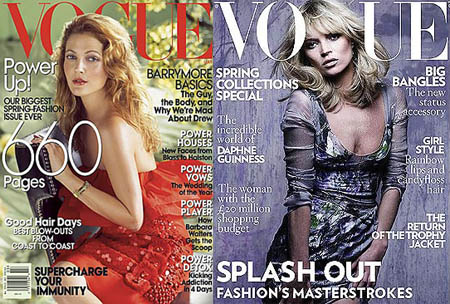
Image source: Style.com and Vogue.co.uk
When March rolls around each year, fashion magazines present their Spring/ Summer fashion issues. This usually means issues of a US-published magazine such as Vogue are hundreds of pages thicker than others times of the year. Most of the additional pages are advertising from fashion brands. UK and European magazine, while still focusing on the upcoming season, maintain their standard, thinner size. As with many similar US versus European comparisons, American Vogue more heavily relies on ad pages to generate revenue, where as British Vogue which is more subscription based business model. Regardless of business model, both maintain their statue in the fashion publishing industry.
As I understand the magazine publishing world, magazine advertisers pay rates based on circulation. Higher circulation leads to higher ad rates. Although, some niche audience magazine will command higher rate for somewhat lower circulation numbers, about the marketing will be more targeted. American Vogue, along with many other magazines published in the US, has the incentive maximize their circulation. One result of this incentive, is that American Vogue has expanded beyond pure fashion editorial, and into what one might call “Vogue lifestyle.”
To spread the appeal of American Vogue, celebrities most often that in the past, grace their covers, rather than the models on their European counterparts. American Vogue’s big spring issue featured Drew Barrymore, where as, British Vogue had supermodel Kate Moss. While Moss is a celebrity herself, she is still primarily known for being a model. A better comparison would be the February 2008 issues, with British Vogue featuring Russian model Sasha Pivovarova (the face of Prada for much of the decade) as opposed to the cover of its American counterpart with actress Kate Bosworth plugging her movie “21”.
The sacrifice of expanding American Vogue’s subject matter, is the decreasing coverage of solely fashion editorial photography and articles. Instead, the magazine covers celebrities, food, beauty, and travel. Admittedly, because American Vogue has a much bigger circulation and therefore bigger budget, the fashion editorial shoots do have higher production values. Further, their food critic,
Chris Anderson of Wired recently published his article on Free. Much of the free content on the web is ad supported. Because ad-based models, including the likes of Goggle, were the initially profitable web media, the Me-toos of the digital world are all following suit. Interesting, in the web 1.0 era, people used to point to the WSJ.com as the golden child site, which got people to pay for it, something that most newspapers have never been able to do.
However, there is something to be still said for pure subscription content model. Anderson is obivously a smart guy, but I hope that his ideas on Free don’t encourage people to blindly pursue ad-based models, without really reading what he is discussing. Towards the end of his article, he notes that in a Free economy, attention and reputation become scare resources, and sometime, that people are willing to pay to receive.
British Vogue is much more narrowly focused on pure fashion editoral, which may make it more niche. But there isn’t anything wrong with that smaller audience of people looking for strong fashion writing and photography. There will always be a market for targeted content, it is just that the standard for what people are willing to pay for has risen. The death of the subscription model is premature and should not be discounted. The game is just a lot harder than it used to be.




Pingback: weather pattern » Blog Archive » Why I subscribe to the Economist, even if I get stressed out when it arrives early.